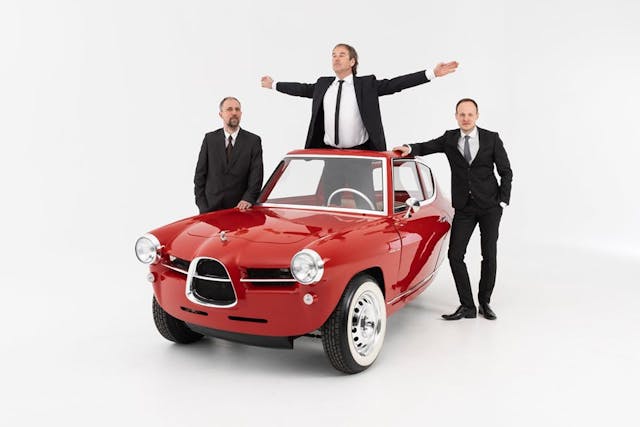Will electric powertrains bring more creative production cars?
While researching a different story, I came across this kitschy EV concept called the Nobe 100, a retrofuturistic three-wheeler that perfectly captures the quirky details of what we love about so many classic cars. The Nobe stood out from the myriad of faux-futuristic pods typically seen in this segment thanks to its looks, borrowing heavily on the family traits of a 1960s Alfa, Saab, or BMW.
The funk doesn’t stop inside, either, with an impossibly-thin steering wheel being flanked by dishplate-sized analog gauges—a refreshing change from the modern era of starship command consoles. Hell, if you picked up one of the €26,221 Indigogo Special Editions, it’ll apparently ship with a coffee maker in the rear fender—we’re talking true innovation for the small-car segment.
Nobe plans to release two variants, the 100 with 75 horsepower and the 100GT with 97 hp, with torque ranging from about 600–800 lb-ft between the two models and range on the scope of 130–160 miles—more with an optional “battery suitcase” that adds 5kw/h to the overall capacity. What’s novel about this three-wheeler over most gasoline models is that it’s all-wheel-drive, with the compact nature of an EV driveline allowing Nobe to power all three wheels without a complicated assortment of chains or driveshafts. This should give the retro-trike a lot of hook, and Nobe’s been championing clips in the snowblind to prove its prowess.
Projects like this have traditionally been hampered by two nasty realities of gasoline engines: their emissions are heavily regulated and difficult to reign in while keeping costs low, and they’re oftentimes much larger than an electric motor with similar output. This frees up projects like Nobe from two of the toughest challenges for small-car builders, which is usually in meeting emissions and crash safety requirements. The result is liberated, low-slung machine that likely will likely have an easier path to production by not having to tinker with the emissions output of a gasoline engine, which has sunk low-price three-wheeler concepts like Elio into purgatory as they work through the expensive process of validating a powertrain.
While the success of Nobe’s crowdfunding aren’t known, it strikes us as something that could only come along at our current crossroads in nostalgia and technology. With the barrier to entry dropping for small-scale manufacturers, we hope to see more creative offerings that break away from the soulless, focus-group-designed appliances we see in showrooms.
Vaporware or retroware? You be the judge—but if you were designing your own EV car, would you reach into the future and build the next DeLorean or would you pull off visions of the past that were previously impossible under old technology?


